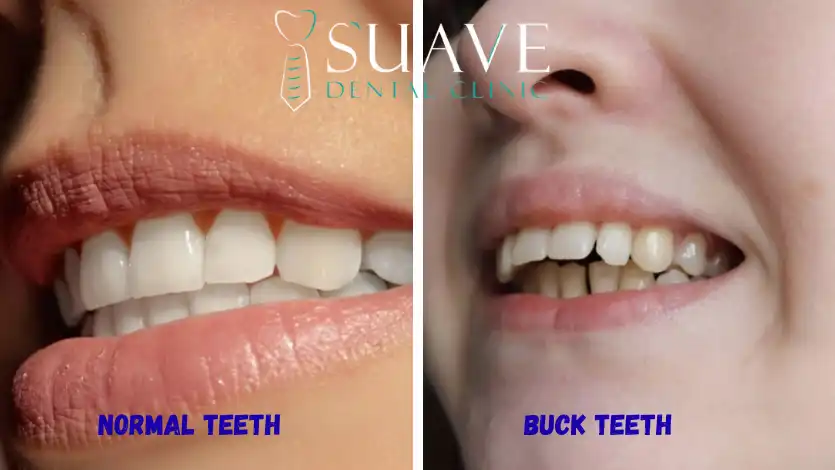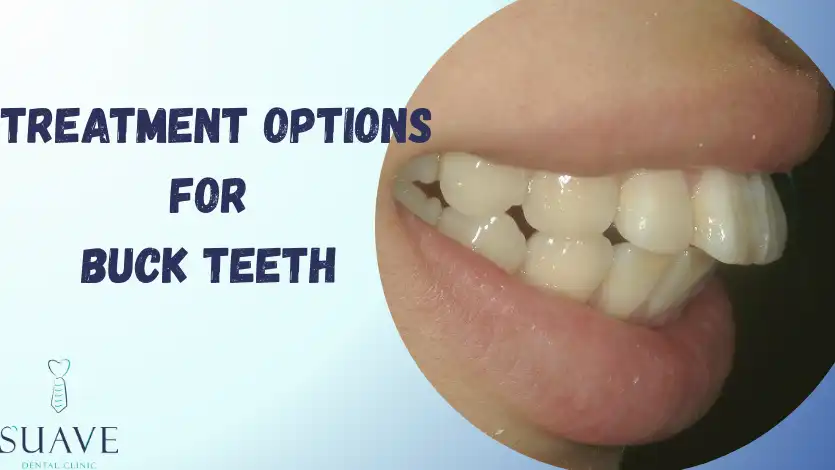
Table of Contents
Imagine a young teen hesitating before smiling for a photo, or a child who struggles to bite into an apple because their teeth don’t meet quite right.
Understanding buck teeth isn’t just about knowing what they are; it’s about exploring their causes, potential impact, and the buck teeth correction options that can transform the smile and the confidence behind it.
What Does Buck Teeth Mean?
In normal occlusion, the top teeth protrude roughly 2-3 mm from the lower teeth.
If this distance exceeds the normal range, it is classified as a type of malocclusion called “overjet”, commonly referred to as buckteeth.
Severe malocclusion cases suffer from overjet and deep overbite, where the upper front teeth may hide the lower front teeth completely, which is known as a deep bite.
What Are The Causes of Buck Teeth?
Overjet teeth can result from several factors, such as:
- Genetic cause:
You are more likely to develop an overjet if your biological parent or sibling has one due to inherited jaw size or teeth alignment pattern. - Childhood Habits
- Thumb sucking:
Children develop this behaviour at a young age. After the age of 4, it may have negative effects (as permanent teeth erupt), pushing them forward and potentially affecting jaw growth. - Tongue thrust
Normally, when babies swallow, their tongue rests against the roof of the mouth. However, it may eventually become a habit in adults.
Mouth breathing usually combines with tongue thrust, where the tongue presses against the back of the upper teeth for a long period, which could have a detrimental effect, as it is not performing properly. - Pacifier use
Prolonged usage of a pacifier, which is a bad habit similar to thumb sucking, can result in teeth protrusion, called pacifier teeth.
- Thumb sucking:
3. Dental cause
- Crowding
Crowded or misaligned teeth can push teeth forward, causing a bunny tooth appearance. - Missing tooth
Loss of a tooth may cause neighboring teeth to tilt into the space, affecting tooth alignment. - Medical problems like dental tumors and cysts could put pressure on the upper top teeth, making them more protruded than usual.

Types of Buck Teeth
Protruded teeth can appear in different forms depending on the cause and the way the teeth protrude:
Dental protrusion
The jaw position is normal, but the upper front teeth are angled forward, in severe protrusion. This is often linked to childhood habits.
Skeletal protrusion
Caused by an upper jaw that is positioned too far forward or a lower jaw that is too far back, making the teeth look more prominent.
Protrusion with a deep overbite
The upper teeth protrude and also cover most of the lower teeth vertically.
Protrusion due to tooth loss or crowding
Losing certain teeth or having overcrowding can cause the front teeth to flare outward.
When Should You Seek Treatment for Buck Teeth?
Overjet teeth are not only an aesthetic concern. They have varied effects on oral function and overall health. You should consider treatment if you experience:
- Difficulty in biting and chewing
- Inability to close your lips comfortably.
- Jaw pain and discomfort
- Ulcers or sore spots on the tongue
- Speech problem
- Less confidence and self-hating
How Are Buck Teeth Treated in Adults and Children?
Orthodontists examine numerous aspects of buck teeth correction, including age, severity of the issue, and how they affect your dental health.
Considering in minds, that children at ages from 7 -12 have buck teeth as apart of mixed dentition of primary and permanent teeth, so buck teeth in this stage called “Ugly Duckling Stage”. This stage is temporary as it completely changes and resolves while the child grow, as their bone grows and their dentition correct itself.
How to fix children’s buck teeth?
If the malocclusion of overjet and overbite is due to bad child habits or genetics, and not normal mixed dentition, orthodontists tend to fix this with:
- Headgear: used to guide jaw growth
- Herbst appliance: correct lower jaw position.
- Palatal expander: widens the upper jaw to enhance alignment.
- Encourage positive changes to stop any bad habits.
How to fix buck teeth in adults?
to get perfect teeth in Adults, orthodontists works to regain the normal overjet and overbite to have the normal bite, these are the treatment options:
- Braces: gradually move teeth to balanced occlusion with wire and metal braces.
- Clear Aligner: Discreet, removable trays for teeth correction, like Invisalign, in mild cases.
- Oral surgery: Used in severe cases, where skeletal bone protrusion is the main cause.
Orthognathic Solutions vs. Orthodontic Solutions for Fixing Protruded Teeth
- Orthodontic solutions for buckteeth (braces, aligners) are primarily effective for correcting teeth misalignment and mild jaw discrepancies, addressing the malocclusion issue caused by the teeth’s positions.
The orthodontic treatment refers to metal wires and braces in moderate and severe cases, and/or clear aligners as Invisalign, in mild cases. - Orthognathic solutions are often combined with orthodontic treatment, mainly used when the cause is related to jaw discrepancy, size, and position.
The orthognathic treatments involve jawbone surgeries that are only used in severe cases.
How To Fix Overjet Without Braces?
With cosmetic dentistry for overjet, the goal is to hide the underlying condition. It is only conceivable if it is an aesthetic concern and the case is mild. There are many options, like
- Dental Veneers: A ceramic shell covers only the front surface of the tooth. In mild cases of overjet, they are used to reshape the front teeth to make them aligned to mask minor protrusion, without any tooth movement.
- Dental crowns: A full coverage restoration. In overjet correction, dentists design it in a way to reduce the protruded teeth appearance and also improve shape and function, especially when the front teeth are weak and destroyed.
- Dental bonding or Composite veneers: A tooth colored material that is applied directly to the teeth. It can be used to adjust the shape of the front teeth, making them less protruded, creating better alignment.
However, these options are not suitable for severe cases, especially when the overjet affects chewing, speaking and oral health at all, orthodontic treatment and even surgery are needed to treat the root cause of the problem.
Oral Health Care When Living With Buck Teeth
In case you decided to live with bunny teeth, there are a few things you can do to keep your teeth healthy and avoid misalignment-related problems:
- Maintain good oral hygiene.
- Schedule routine dental checkups.
- Wear a nightguard while sleeping or during stressful periods if you tend to thrust your tongue.
- Use a mouth guard to protect your teeth during high-impact sports.
- boost your confidence with that your smile is priceless, and don’t care for other thoughts.
Is It Possible To Prevent Buck Teeth?
Preventing teeth protrusion starts with simple, consistent habits, especially during childhood. By addressing harmful behaviors early and protecting teeth from injury, you can greatly reduce the risk of misalignment.
- Break harmful habits early (thumb sucking, prolonged pacifier use, tongue thrusting).
- Schedule regular dental checkups.
- Encourage proper chewing habits for healthy jaw development.
While buck teeth are common, they don’t have to define how you feel about yourself.
If you suspect you or your child may have protruding teeth, consulting an orthodontist early can make all the difference, not just for your teeth, but for your overall quality of life.
Buck Teeth FAQs
How do dentists treat buck teeth that are not so extreme?
In mild cases, when the issue only affects appearance, orthodontists may use cosmetic dentistry to correct buck teeth.
What is the best age to fix buck teeth?
At around age 7, when a child had buck teeth due to bad habits like thumb sucking and pacifiers teeth, or due to skeleteal problems. Early detection of the problem makes treatment easier and more affordable.
Do buck teeth cause harm to your mouth?
Yes, they can have noticeable impacts on your oral health, such as:
– Improper alignment
– Enamel wear of lower teeth
– Difficulty in brushing and flossing
– Increase risk of cavities and gum disease
– Increase risk of dental trauma
The worse the case, the more difficult the symptoms, the more complex the treatment.
Are buck teeth ok?
Not necessarily; their effects may be mild enough for some people to live without treatment, but they certainly impact appearance.
Is it possible to fix buck teeth at home?
Impossible. You should consult with your orthodontist to determine the best treatment option for your situation.
Why is it called buck teeth?
It comes from their resemblance to the prominent front teeth of a male deer, known as a buck.
Are buck teeth rare?
No, it is considered a common malocclusion worldwide. One study suggests the worldwide prevalence of malocclusion (a related term) is 56%.
References
Medically Reviewe